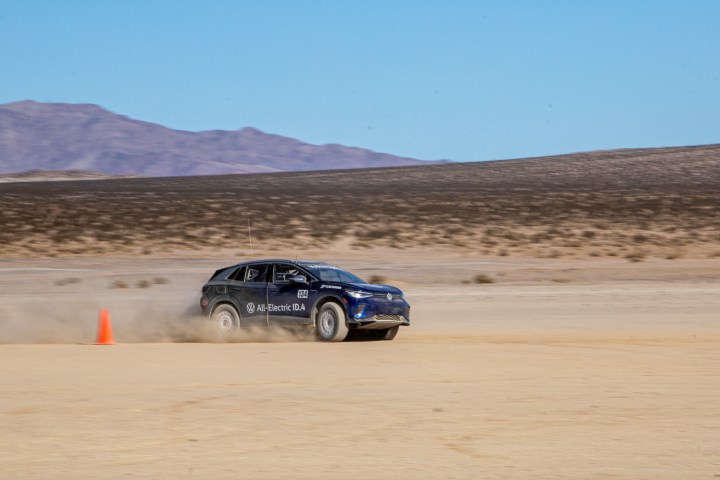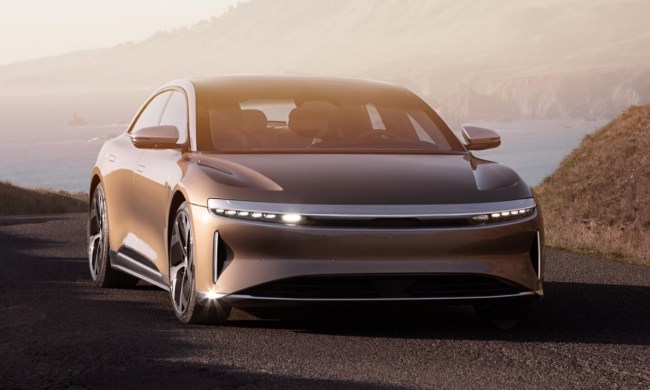An ominous thud startles me as the ID.4 hits the dry desert earth, kicking up a plume of silky dust ahead of another whoop-dee-doo. I brace for a front-end scrape that doesn’t happen and I remind myself as I depress the accelerator, if this EV survived the punishing NORRA Mexican 1000, it can certainly handle whatever I can dish out.
I’m at the Soggy Dry Lake off-road recreation area an hour north of Palm Springs, California, and in my mind, I’m pummeling an EV beyond its capabilities. But I’m not. I’m here because Volkswagen has offered up two specially modified ID.4s and a 1969 Beetle for me to drive around the desert to prove that EVs are capable off-roaders — and that Baja Beetles are still great but also unwieldy compared to today’s offerings. All three vehicles readily handle the rough terrain and pounds of dust that fly off the desert floor in their wake. As far as I can tell, the vehicles are not in the least bothered by my driving or my concerns.
So as I momentarily fret about the rear suspension of the First Edition rear-wheel-drive (RWD) vehicle I continue to slam into the ground, I take refuge in the knowledge that it didn’t just complete the NORRA race, it was the first production EV to do so. The road and I are inconsequential to this EV, so I go faster.

A new experience
Up until now, EVs have largely been an on-road affair. Tesla, GM, Hyundai, Ford — they’ve all released electric vehicles that are meant to reside on asphalt. Outside of electric motorcycle offerings and the Rivian R1T, automakers aren’t highlighting the off-road capabilities of their electron-powered vehicles. Then Volkswagen decided to take its rather tame ID.4 and throw it into the desert — twice — and offered me the opportunity to try them both out.
The second, more colorful ID.4 I get behind the wheel of is the newer ID.4 AWD Pro, an all-wheel-drive version of the electric SUV that offers better traction and more power. It competed in the Rebelle Rally, an all-women rally raid event held in Nevada and California. This psychedelic rainbow on four wheels is more civilized than its NORRA cousin. The radio and climate control work. It even has the factory seats and seat belt. But even with CarPlay capability intact, it’s not your average ID.4.

Both ID.4s got huge suspension upgrades and their radiators were moved up a few inches to increase the approach angle and help with cooling. That new angle adjustment is why I could tackle a steep bump without the front of the vehicle scraping the ground. Added skid plates protect the underside, while a lift increases ground clearance, and off-road tires provide better traction.
I’ve driven the regular ID.4. This was a new experience that could only have been accomplished with these modifications. An ID.4 straight off the showroom floor would likely have bottomed out every 10 feet and definitely would have had serious difficulty taking on the knotted road to the lake bed. But where the Rebel Rallye ID.4 was comfortable, the NORRA was all business.
With most of the interior removed, the windows replaced with a tiny plastic slider, and a roll cage that made me regret not taking up yoga as I bent my arms and legs into unnatural positions to take a seat, the RWD ID.4 took quite a beating (or at least I think it did) while I was behind the wheel. Should you be jumping an EV on a narrow road rutted with holes, bumps, and ruts deep enough to swallow a pony? Probably not? But I did. Again and again, as my body strained but was held firm by the five-point harness seat belt.

Smart and safe
On the actual lake bed, Volkswagen set up an autocross course to help me experience the difference between the two vehicles. Sure the NORRA ID.4 felt ready to take on the world, but it was slower off the line and cornering wasn’t as tight. The Rebelle Rally AWD version was quicker, and thanks to all four wheels digging into the dirt, better-suited for the tight slalom Volkswagen had set up. Yet, even with all the aftermarket suspension and tires and roll cages, there was one thing the VWs couldn’t do, and that’s break free and drift. Turns out that’s a feature, not a bug (pun not intended).
Both ID.4s still had their traction and stability controls switched on. Volkswagen says that these can’t be defeated from the car and would essentially require someone to go into the vehicle’s digital guts to turn them off. The result was a loss of power around corners as the vehicle tried to correct a slide it was about to experience. It was especially frustrating with the RWD variant as oversteer makes for not only an exciting driving experience, but can be used to keep the momentum while cornering.
While the system made desert driving a little less fun, it’s a good indicator that Volkswagen’s safety systems are ready for even the slickest roads out in the real world. The same technology that squelched my ability to whip the tail around on a dry lake bed will likely keep someone driving in the rain from sliding off the road.
Even with the system on, the colorful AWD ID.4 displayed the ruggedness a vehicle would need to handle the rigors of the desert. It felt more civilized on the track and on the bump-laden road in the way that Captain American is more civilized than the Hulk. Both still get the job done, but one is a bit smarter about getting to the desired result.
All the upgrades in the world won’t change the fact that the ID.4s needed something the gas-powered vehicles in the competitions didn’t, a place to charge. For the NORRA, a charging station connected to a biodiesel generator was used. When that wasn’t available, the vehicle was flat-towed for a short distance until the regenerative system added enough juice to make it to the next scheduled stop.

A common thread
Then there was the Beetle. A late ’60s four-speed, rear-wheel-drive beast that likely has seen so much off-roading that its metal is fused with dust. The idea was to experience the evolution of VW off-roading. From Beetle to rear-wheel-drive ID.4, to all-wheel-drive version. Sure the inclusion of the Beetle seemed a bit weird considering it was built over half a century ago, but let’s just go with it, shall we?
Unlike its more safety-focused distant cousins, the Beetle was mostly sideways while I was behind the wheel. Without traction control, the slick desert ground kept me spinning the steering wheel back and forth to stay on course. I also ended up lifting the passenger wheels off the ground a few times — something the ID.4s were likely not to encounter anytime soon thanks to the low center of gravity afforded them by their battery packs.
While it was weird to show the evolution from the Beetle to the ID.4, there is a common thread: The Beetle wasn’t built with off-roading in mind. The first Baja Bug is believed to have been built in 1968. As soon as that happened, taking a bug and modifying it to tackle the rigors of dirt became a worldwide phenomenon. It was a vehicle built for everyday use that was transformed by some into something slightly insane. Volkswagen did the same thing with the two ID.4s I drove.
Volkswagen’s decision to create off-road ID.4s is less of an organic origin story. The company wanted to see what would happen if it took its first long-range EV to land in the United States and give it some dirt-tackling muscle. The automaker’s future plans for additional off-road vehicles are unclear. But the seed has been planted. Once EV and off-roading enthusiasts see what can be done with suspension upgrades, new wheels and tires, and relocating the radiator, other ID.4s and EVs will start to appear at off-road events. All of the changes made to these VWs are typical of those made to gas-powered vehicles.
Off-roading, like the highways of the world, is about to undergo an evolution. A dirt world that’s greener, quieter, and if you can get those pesky stability systems to turn off, just the right amount of sideways.



